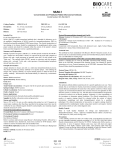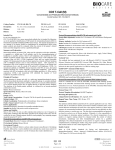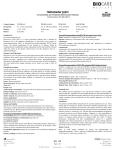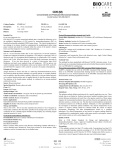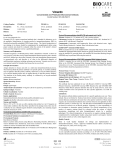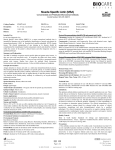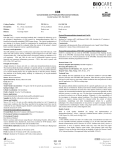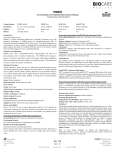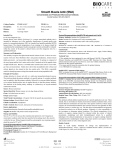Download Data Sheet
Transcript
ALK [5A4] Concentrated and Prediluted Monoclonal Antibody Control Number: 901-3041-033115 Catalog Number: ACI 3041 A, B API 3041 AA OAI 3041 T60 Description: 0.1, 0.5 ml, concentrated 6.0 ml, prediluted 60 tests, prediluted Dilution: 1:50-1:100 Ready-to-use Ready-to-use Diluent: Renoir Red N/A N/A Intended Use: For In Vitro Diagnostic Use ALK [5A4] is a mouse monoclonal antibody that is intended for laboratory use in the qualitative identification of aa 419-520 of ALK protein or ALK-NPM chimeric protein by immunohistochemistry (IHC) in formalin-fixed paraffin-embedded (FFPE) human tissues. The clinical interpretation of any staining or its absence should be complemented by morphological studies using proper controls and should be evaluated within the context of the patient’s clinical history and other diagnostic tests by a qualified pathologist. Summary and Explanation: ALK (p80) recognizes the formalin-resistant epitope of native anaplastic lymphoma kinase (ALK) protein. ALK recognizes a 200 kDa transmembrane molecule expressed only in neural tissues. The ALK reacts with normal ALK protein, as well as with the chimeric protein ALK-NPM. ALK specifically labels t(2;5)-positive cells giving strong cytoplasmic staining that is also associated with nuclear staining. Anaplastic large cell lymphoma (ALCL) is a heterogeneous group of diseases by morphology, immunophenotyping and clinical presentation. It can be difficult to diagnose because of its similarity to Hodgkin's lymphoma. However, treatment and prognosis of Hodgkin's and ALCL is very different, and it is imperative to diagnose correctly. Research has also shown that a subset of lung adenocarcinomas harbor rearrangements of the ALK gene that results in the pathologic expression of a fusion protein, most commonly EMLA-ALK. Patients with ALK-rearranged lung adenocarcinomas are unresponsive to tyrosine kinase inhibitors that target EGFR, but have shown dramatic improvement in response to tyrosine kinase inhibitors that target ALK in ongoing clinical trials. The results from studies comparing FISH, CISH and IHC were concordant. The sensitivity and specificity of IHC was reported as 100% and 95% respectively. Based on these findings, the IHC assay using the 5A4 antibody reliably detected non-small cell lung cancer with ALK rearrangement and may be useful as a screening method to identify these tumors. Research has shown that ALK stains the majority of CD30+ ALCL. It has not been shown to stain Hodgkin's disease (Reed-Sternberg cells). ALK should be used in a panel with CD15, CD30, TIA-1 and EMA. Principle of Procedure: Antigen detection in tissues and cells is a multi-step immunohistochemical process. The initial step binds the primary antibody to its specific epitope. A secondary antibody may be applied to bind the primary antibody, followed by an enzyme labeled polymer; or an enzyme labeled polymer may be applied directly to bind the primary antibody. The detection of the bound primary antibody is evidenced by an enzyme-mediated colorimetric reaction. Source: Mouse monoclonal Species Reactivity: Human; others not tested. Clone: 5A4 Isotype: IgG1 Total Protein Concentration: ~10 mg/ml. Call for lot specific Ig concentration. Epitope/Antigen: aa 419-520 of NPM-ALK transcript Cellular Localization: Cytoplasmic and nuclear staining (dot-like) Positive Control: Anaplastic large cell lymphoma Known Applications: Immunohistochemistry (formalin-fixed paraffin-embedded tissues) Supplied As: Buffer with protein carrier and preservative Storage and Stability: Store at 2ºC to 8ºC. Do not use after expiration date printed on vial. If reagents are stored under conditions other than those specified in the package insert, they must be verified by the user. Diluted reagents should be used promptly; any remaining reagent should be stored at 2ºC to 8ºC. ISO 9001&13485 CERTIFIED Protocol Recommendations (manual use): Peroxide Block: Block for 5 minutes with Biocare's Peroxidazed 1. Pretreatment Solution: Reveal Pretreatment Protocol: Heat Retrieval Method: Retrieve sections under pressure using Biocare’s Decloaking Chamber, followed by a wash in distilled water; alternatively, steam tissue sections for 45-60 minutes. Allow solution to cool for 10 minutes then wash in distilled water. Protein Block (Optional): Incubate for 5-10 minutes at RT with Biocare's Background Punisher. Primary Antibody: Incubate for 30-60 minutes at RT Probe: Incubate for 10 minutes at RT with a secondary probe. Polymer: Incubate for 10 minutes at RT with a tertiary polymer. Chromogen: Incubate for 5 minutes at RT with Biocare's DAB - OR - Incubate for 5-7 minutes at RT with Biocare's Warp Red. Counterstain: Counterstain with hematoxylin. Rinse with deionized water. Apply Tacha's Bluing Solution for 1 minute. Rinse with deionized water. Protocol Recommendations (ONCORE Automated Slide Staining System): OAI3041 is intended for use with the ONCORE Automated Slide Staining System. Refer to the ONCORE Automated Slide Staining System User Manual for specific instructions on its use. Protocol parameters in the ONCORE Automated Slide Stainer Protocol Editor should be programmed as follows: Protocol Name: ALK Protocol Template (Description): Ms HRP Template 1 Dewaxing (DS Option): DS2 Antigen Retrieval (AR Option): AR1, high pH; 103°C Reagent Name, Time, Temp.: ALK, 30 min., 25°C Technical Note: This antibody has been optimized for use with Biocare's MACH 4 Universal HRPPolymer Detection and ONCORE HRP Detection. Other Biocare polymer detection kits may be used; however, users must validate incubation times and protocols for their specific application. Use TBS buffer for washing steps. Limitations: The optimum antibody dilution and protocols for a specific application can vary. These include, but are not limited to fixation, heat-retrieval method, incubation times, tissue section thickness and detection kit used. Due to the superior sensitivity of these unique reagents, the recommended incubation times and titers listed are not applicable to other detection systems, as results may vary. The data sheet recommendations and protocols are based on exclusive use of Biocare products. Ultimately, it is the responsibility of the investigator to determine optimal conditions. The clinical interpretation of any positive or negative staining should be evaluated within the context of clinical presentation, morphology and other histopathological criteria by a qualified pathologist. The clinical interpretation of any positive or negative staining should be complemented by morphological studies using proper positive and negative internal and external controls as well as other diagnostic tests. Quality Control: Refer to CLSI Quality Standards for Design and Implementation of Immunohistochemistry Assays; Approved Guideline-Second edition (I/LA28-A2) CLSI Wayne, PA USA (www.clsi.org). 2011 Page 1 of 2 ALK [5A4] Concentrated and Prediluted Monoclonal Antibody Control Number: 901-3041-033115 Precautions: 1. This antibody contains less than 0.1% sodium azide. Concentrations less than 0.1% are not reportable hazardous materials according to U.S. 29 CFR 1910.1200, OSHA Hazard communication and EC Directive 91/155/EC. Sodium azide (NaN3) used as a preservative is toxic if ingested. Sodium azide may react with lead and copper plumbing to form highly explosive metal azides. Upon disposal, flush with large volumes of water to prevent azide build-up in plumbing. (Center for Disease Control, 1976, National Institute of Occupational Safety and Health, 1976) (6) 2. Specimens, before and after fixation, and all materials exposed to them should be handled as if capable of transmitting infection and disposed of with proper precautions. Never pipette reagents by mouth and avoid contacting the skin and mucous membranes with reagents and specimens. If reagents or specimens come into contact with sensitive areas, wash with copious amounts of water. (7) 3. Microbial contamination of reagents may result in an increase in nonspecific staining. 4. Incubation times or temperatures other than those specified may give erroneous results. The user must validate any such change. 5. Do not use reagent after the expiration date printed on the vial. 6. The SDS is available upon request and is located at http://biocare.net/. ISO 9001&13485 CERTIFIED Troubleshooting: Follow the antibody specific protocol recommendations according to data sheet provided. If atypical results occur, contact Biocare's Technical Support at 1-800-542-2002. References: 1. Falini B, et al. ALK expression defines a distinct group of T/Null lymphomas (“ALK lymphomas”) with a wide morphological spectrum. Am J Pathol. 1998 Sep; 153(3):875-86. 2. Mino-Kenudson M, et al. A novel highly sensitive antibody allows for the routine detection of ALK-rearranged lung adenocarcinomas by standard immunohistochemistry. Clin Cancer Res. 2010 Mar 1; 16(5):1561-71. 3. Paik JH, et al. Screening of anaplastic lymphoma kinase rearrangement by immunohistochemistry in non-small cell lung cancer: correlation with fluorescence in situ hybridization. J Thorac Oncol. 2011 Mar; 6(3):466-72. 4. Kim H, et al. Detection of ALK gene rearrangement in non-small cell lung cancer: a comparison of fluorescence in situ hybridization and chromogenic in situ hybridization with correlation of ALK protein expression. J Thorac Oncol. 2011 Aug; 6(8):1359-66. 5. McLeer-Florin A, et al. Dual IHC and FISH testing for ALK gene rearrangement in lung adenocarcinomas in a routine practice: a French study. J Thorac Oncol. 2012 Feb; 7(2):348-54. 6. Center for Disease Control Manual. Guide: Safety Management, NO. CDC-22, Atlanta, GA. April 30, 1976 "Decontamination of Laboratory Sink Drains to Remove Azide Salts." 7. Clinical and Laboratory Standards Institute (CLSI). Protection of Laboratory Workers from Occupationally Acquired Infections; Approved Guideline-Fourth Edition CLSI document M29-A4 Wayne, PA 2014. Page 2 of 2



